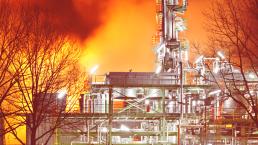Process Hazard Analysis
ProSCon Engineering experts choose Process Hazard Analysis for your business with international trainings and different sector experiences, determine the evaluation schedule according to the standards and lead the studies.
Process Hazard Analysis (PHA) is defined as the whole of systematic and organized studies to identify potential hazards in industrial processes. We perform process hazard analysis as a team with our project partners.
We determine Process Hazards using one or more of the following analysis methods, depending on the design level of the process to be evaluated and on demand:
- PrHA (Preliminary Hazard Analysis)
- HAZOP (Hazard and Operability)
- What If Study, Sector – Based checklist studies,
- FMEA (Failure Mode and Effects Analysis),
- LOPA(Layer of Protection Analysis), SIL (Safety Integrity Level)
- SIL (Safety Integrity Level)
Many methods of analysis can be used to identify process hazards. Choosing the right method of analysis is also very important. At this point, we start the projects by applying the internationally accepted selection techniques and determining which analysis or analysis should be used in which order.

We aim to add value to process control as well as identifying process hazards of the facility we work with for Process Hazard Analysis.
It should be noted that the efficiency of Process Hazard Analysis will become the direct efficiency of safety management and is of high importance in the sustainability of process safety in enterprises.
HAZOP Study (Hazard and Operability Study)
The most common use in the Process Hazard Analysis in the chemical sector is the HAZOP Study. HAZOP Study is a method performed in accordance with IEC 61882 standard and has been applied for many years in secure process designs and major changes. In this study, deviations from process conditions and binary variable method are examined and the adequacy of existing process control systems can be evaluated. In HAZOP Study, deviations from the process conditions are evaluated by creating scenarios with reasons and results and, if desired, can form a basis for semi-numerical and numerical evaluation methods.
The most important plus of the HAZOP Study is that the results of the study systematically reveal the dangers and the problems of operability. The characteristic feature of HAZOP studies is to create a multidisciplinary team with the help of a leader and analyze them in sessions. HAZOP Study consists of 4 main stages according to IEC 61882 standard;
- Definitions
- Preparation
- Working
- Documentation and follow-up
In the identification phase, the objectives and the team are determined by revealing the requirements of the project. The preparatory phase is the stage where the project schedule is established and the logistic elements are determined. In the working phase, the process to be carried out in HAZOP study is firstly broken into pieces and the work continues with NODE determination. Determined NODEs are subjected to binary variable method. Scenarios are created according to deviations of important parameters from process conditions and the adequacy of existing process control methods are analyzed.
If the HAZOP Study is used for the substructure of a semi-numerical or numerical method, reference may be made to the method to be evaluated in part of the recommendations.
Safety Integrity Level (SIL) Analysis
Process hazard analysis performed in Process Safety studies helps us to map for safe process design. The output obtained in the process hazard analysis is described as Safety Instrumented Function (SIF). At this point, IEC 61508 and IEC 61511 standards allow us to determine the level of safety integrity within Functional Safety.
How can I determine the SIL level of my system with the required safety instrument?
According to IEC 61508: part 5 and IEC 61511: part 3, the SIL requirement can be determined using the following methods.
- ALARP Method
- Risk Graph Method
- Risk Matrix Method
- Fault Tree Analysis (FTA)
- Layers of Protection Analysis (LOPA)

Process hazard analysis is considered as the first phase in the Functional Safety Life Cycle. After the process hazard analysis, the safety integrity levels (SIL) of safety instrumented functions (SIF) can be determined using the methods specified in IEC 61508 and IEC 61511 standards for safe process design.
"7" Essentials in Process Hazard Analysis
Process Hazards Examination of previous incidents, accidents and near misses. Engineering and / or management measures related to danger. Failure results of engineering and / or management measures. Facility layout (placement of various risk elements within the facility) Human factors (including operator, maintenance, management) Quantitative evaluation of process safety events as a result of control errors.
Our engineers carry out LOPA and SIL analyzes to determine the requirements and safety levels after the process hazard analysis.

















 Takipte Kalın
Takipte Kalın